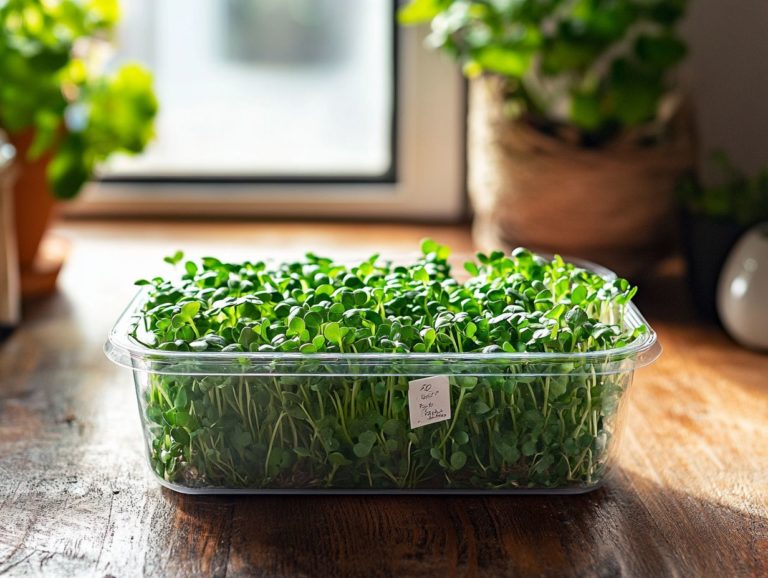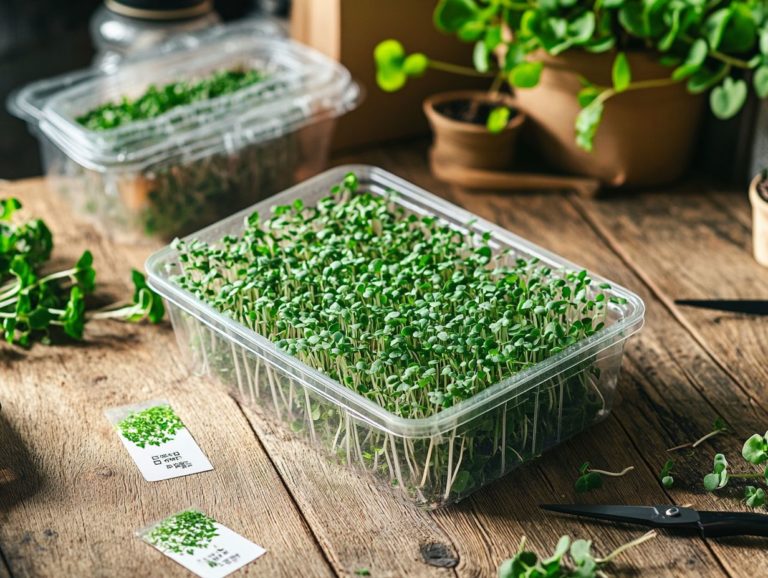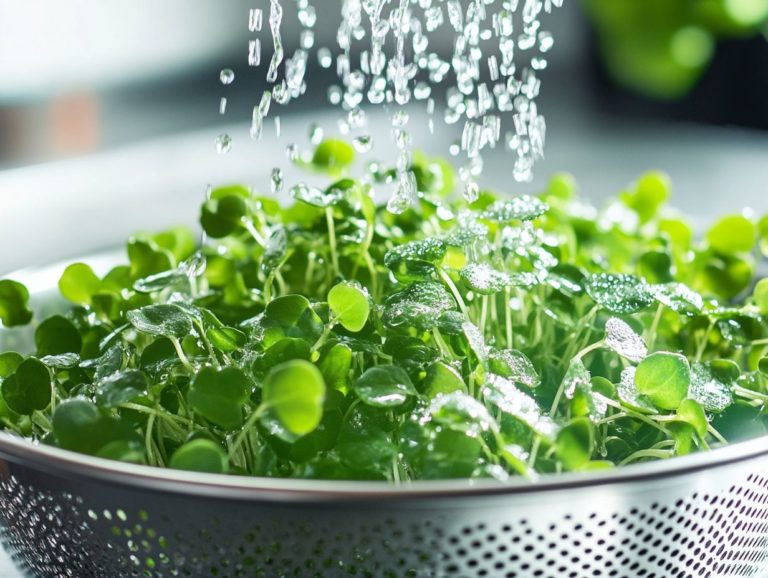Understanding the Nutritional Profile of Microgreens
Microgreens aren t merely trendy garnishes; they deliver an impressive nutritional boost in a compact form. Imagine boosting your health with these tiny wonders!
Often mistaken for sprouts, these vibrant young plants are harvested right after their first true leaves emerge. They offer delightful flavors along with a host of health benefits.
This article delves into what microgreens are, their remarkable nutritional overview compared to other greens, popular varieties available, and a straightforward guide on how to grow and incorporate them into your meals.
Uncover how these petite greens can transform your health and elevate your culinary adventures!
Contents
Key Takeaways:
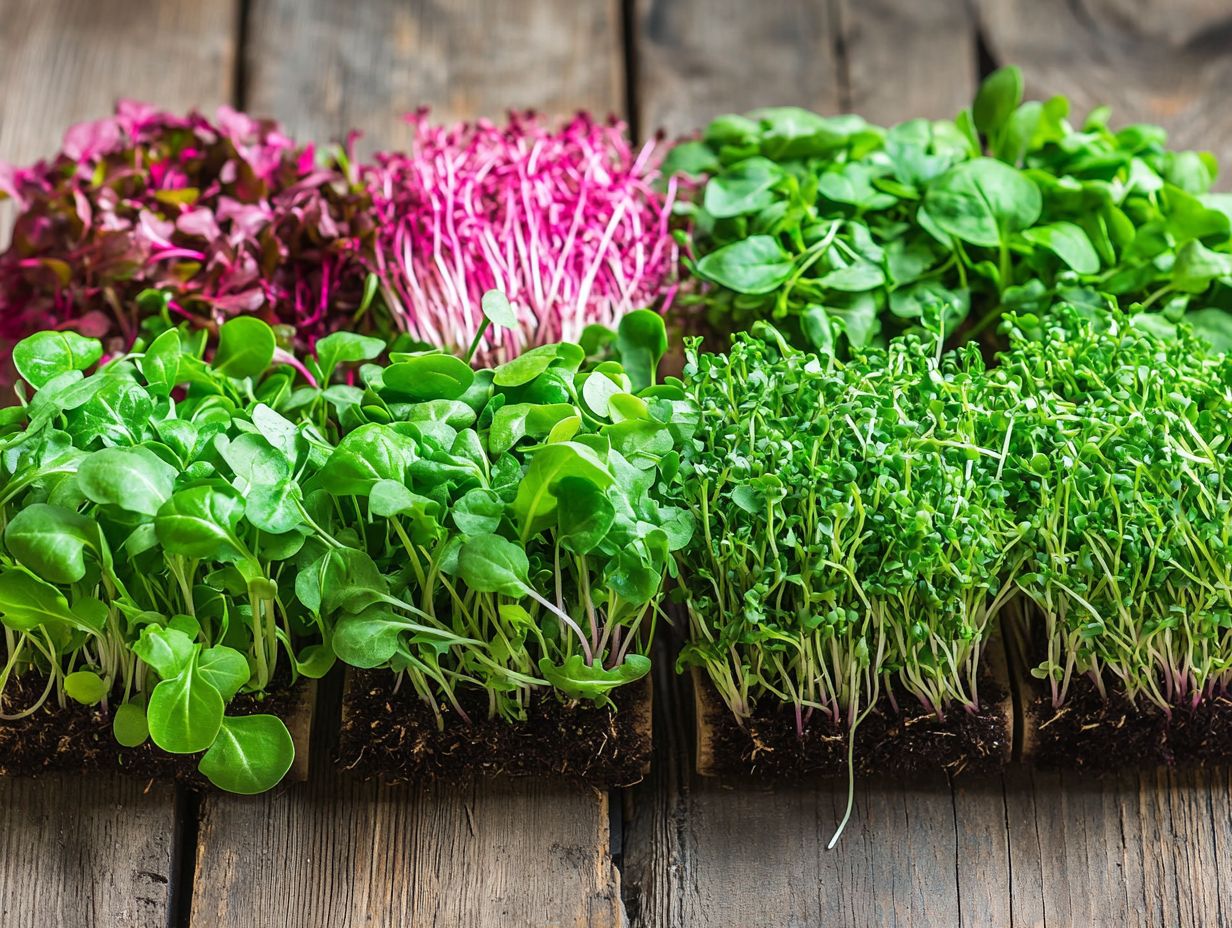
- Microgreens are tiny, nutrient-dense plants harvested at an early stage of growth.
- Despite their small size, microgreens offer a higher concentration of vitamins, minerals, and antioxidants compared to their fully grown counterparts.
- Incorporating microgreens into your diet can boost your overall nutrient intake and potentially provide various health benefits, making them a great addition to any meal.
What are Microgreens?
Microgreens are delightful young plants harvested right after their first true leaves emerge. They deliver a concentrated burst of nutrients that your body can easily use.
These vibrant, nutrient-dense greens come in a variety of types, such as broccoli, pea shoots, and sunflower microgreens. They elevate culinary dishes with their striking colors and bold flavors.
By incorporating microgreens into your diet, you re indulging in a rich source of vitamins, minerals, and antioxidants. You re also supporting sustainable agriculture while reaping a multitude of health benefits.
Definition and Characteristics
Microgreens are young edible plants that you can harvest at an early stage of growth, usually between 7 to 21 days. These little powerhouses are brimming with essential nutrients and vibrant flavors.
You ll find these tiny greens come in various species, including radishes, kale, basil, and arugula. Each brings its unique tastes and textures to the table, ready to enhance your dishes.
Grown in soil or hydroponically, they flourish best in controlled environments, providing the perfect balance of light and moisture. Their versatility means you can effortlessly use them in salads, sandwiches, and garnishes.
Packed with vitamins C, E, and K, along with beneficial antioxidants, microgreens combat chronic illnesses. They not only amplify flavor profiles but also contribute to a health-conscious diet.
Nutritional Value of Microgreens
The nutritional value of microgreens is remarkable, offering a concentrated source of vitamins and minerals that often surpasses that of their mature counterparts.
Packed with essential nutrients like vitamin A, vitamin C, vitamin K, and protein, microgreens make an excellent addition to your healthy diet. To learn more about their benefits, check out what nutrients do microgreens provide? They contain antioxidants that fight oxidative stress in your body, making them a genuine powerhouse of health benefits.
Comparing Nutrient Density to Other Greens
When comparing nutrient density, you’ll discover that microgreens often outshine traditional leafy greens. They showcase higher concentrations of essential vitamins, minerals, and natural compounds found in plants crucial for your optimal health.
This impressive nutritional profile becomes particularly striking with varieties like kale, arugula, and radish microgreens. These can deliver significantly elevated levels of vitamins C, E, and K compared to their mature counterparts, highlighting why microgreens are essential for a balanced diet.
For instance, microgreens can pack up to six times more vitamin C than mature kale leaves, enhancing your body’s antioxidant protection. They also boast a wealth of essential minerals such as iron, calcium, magnesium, and phosphorus, supporting vital bodily functions like bone health and energy production. To learn more about the benefits of these greens, check out what are the most nutritious microgreens?
With their exceptional nutrient density, microgreens can be a delightful and healthful addition to your salads, smoothies, and various dishes, enriching your well-rounded diet.
Types of Microgreens
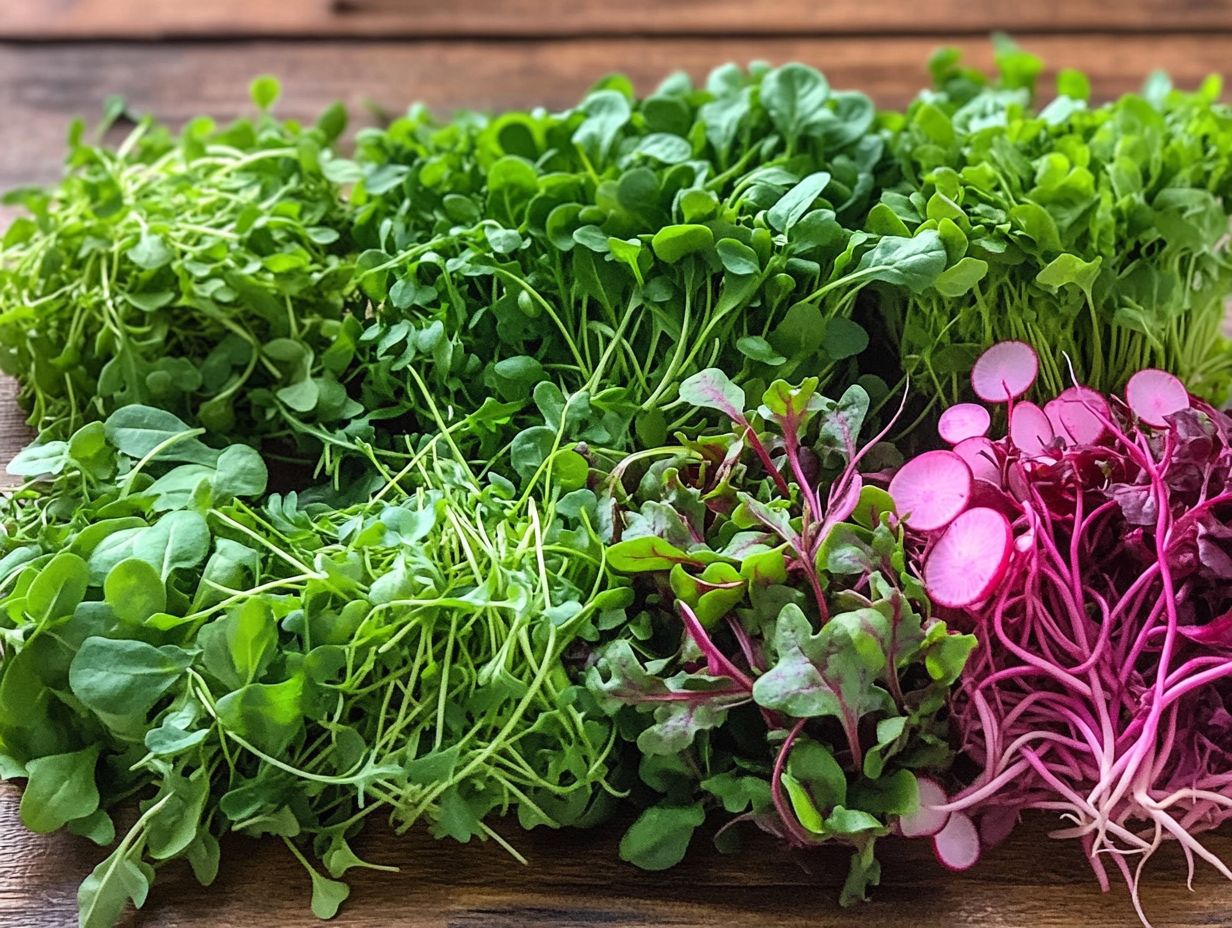
Microgreens come in a delightful array, each with unique flavors and health benefits. They make exceptional ingredients for your meals.
Standout varieties include broccoli microgreens, known for their sulforaphane content, and pea shoots, which are high in dietary fiber. Sunflower microgreens are rich in essential nutrients like calcium and magnesium.
Popular Varieties and Their Benefits
Popular microgreens such as broccoli, pea shoots, sunflower, and radish aren’t just flavorful; they offer amazing health benefits.
Broccoli microgreens are loaded with sulforaphane, a compound known for fighting cancer. Pea shoots add a sweet flavor and are a great source of protein.
Sunflower microgreens have a nutty taste and are packed with healthy fats and potassium, which are great for your heart. Radish microgreens bring a peppery kick and are full of antioxidants.
Adding these vibrant greens to your meals can elevate your cooking and nutrition, supporting your journey toward healthy living.
Growing and Harvesting Microgreens
Growing microgreens is simple and sustainable. You can grow them indoors or outdoors for fresh produce year-round.
This guide will walk you through the steps, from choosing seeds to finding the right light for healthy growth.
Step-by-Step Guide
To grow microgreens successfully, focus on soil preparation, light exposure, and watering techniques.
Start with a nutrient-rich, well-draining soil. You can use a pre-mixed seed starting soil or make your own by blending potting soil with compost.
Ensure your microgreens get bright, indirect light. Place lights about 6-12 inches above your plants to encourage healthy growth.
Establish a consistent watering schedule. Mist the soil daily to keep it moist without overwatering. Monitor humidity and ensure air circulation to prevent mold.
How to Incorporate Microgreens into Your Diet
Incorporating microgreens into your meals is a tasty choice with numerous health benefits.
Sprinkle them on salads, add them to sandwiches, or blend them into smoothies. These vibrant greens will transform any dish with essential nutrients and rich flavors.
Recipe Ideas and Tips
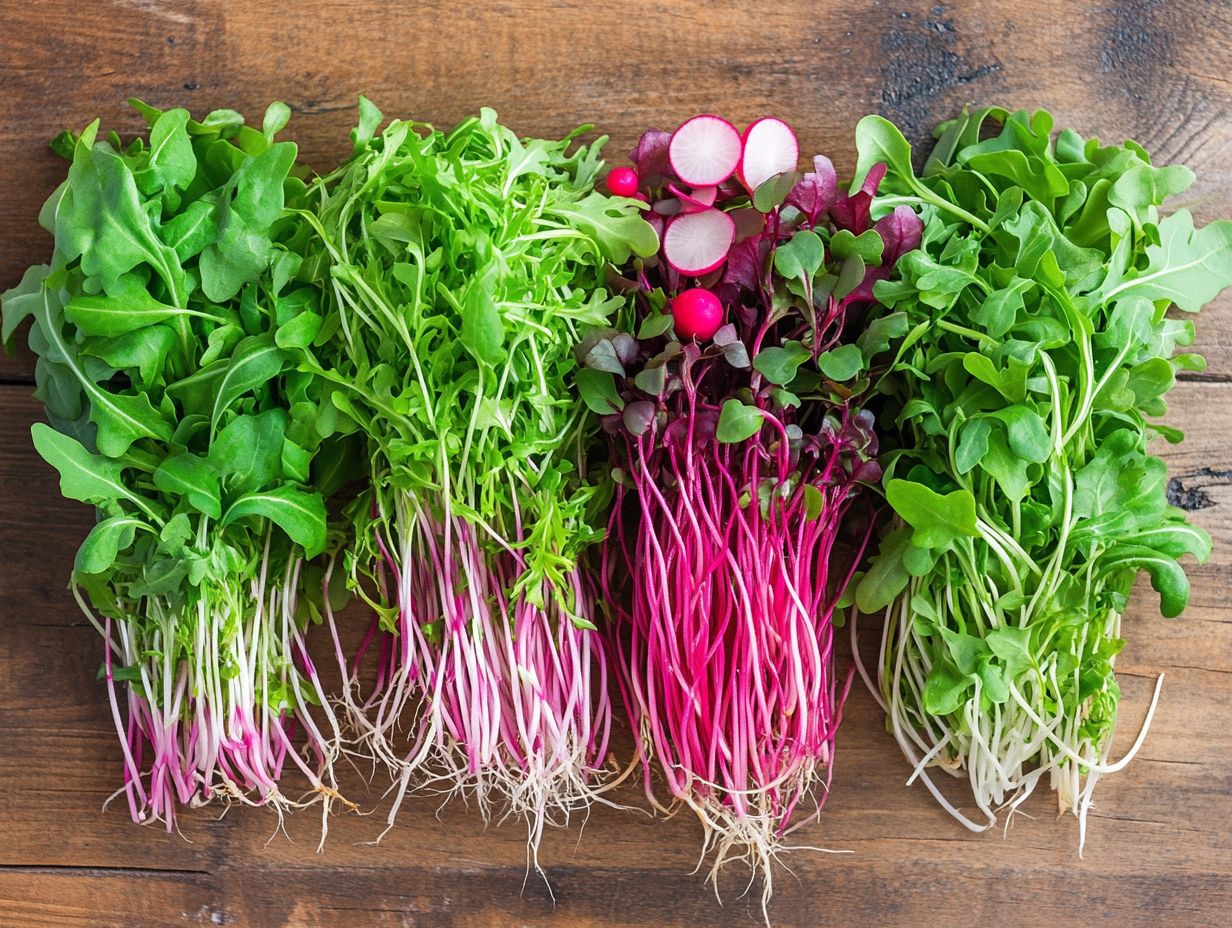
Dive into an array of recipe ideas and tips for utilizing microgreens. From vibrant salads to nutrient-packed smoothies, these petite greens showcase their incredible culinary versatility.
These petite greens do more than just brighten up your plate; they deliver a substantial nutritional boost as well. Imagine enjoying a refreshing salad with arugula microgreens, juicy cherry tomatoes, and a light vinaigrette that brings a delightful burst of freshness to your palate while unlocking the antioxidant power of microgreens.
Blend pea shoot microgreens into a smoothie alongside bananas and spinach to significantly enhance flavor and health benefits. The peppery kick of radish microgreens can elevate your tacos or grain bowls, transforming them into truly satisfying dishes.
Exploring these recipes helps you easily incorporate microgreens into your meals, turning even the simplest creations into culinary treasures.
Potential Health Benefits of Microgreens
Microgreens offer remarkable health benefits. They support your immune system, aid in detoxification, and may even have anti-cancer properties. Embracing these tiny powerhouses can enhance your overall well-being.
Research and Evidence
Research suggests that incorporating microgreens into your diet can significantly reduce the risks of chronic illnesses, including heart disease and diabetes. Thanks to their impressive antioxidant content and essential nutrients, they are a valuable addition to your meals.
These vibrant greens are not just a pretty addition to your plate; they are packed with vitamins and minerals that enhance your body’s nutrient absorption. A recent study published in the Journal of Agricultural and Food Chemistry revealed that microgreens boast significantly higher levels of vitamins C, E, and K compared to their mature counterparts. Additionally, their anti-inflammatory properties may help lower the risks associated with diseases like heart disease and diabetes. Discover why microgreens are superfoods you need.
By adding microgreens to your meals, you re not only elevating the flavor but also fortifying your defenses against chronic health issues. They truly are a valuable asset to any healthy eating strategy.
Frequently Asked Questions
What exactly are microgreens?
Microgreens are young seedlings of edible vegetables and herbs. They are harvested early, usually 1-3 weeks after germination, and are known for their strong flavors and vibrant colors.
What is the nutritional profile of microgreens?
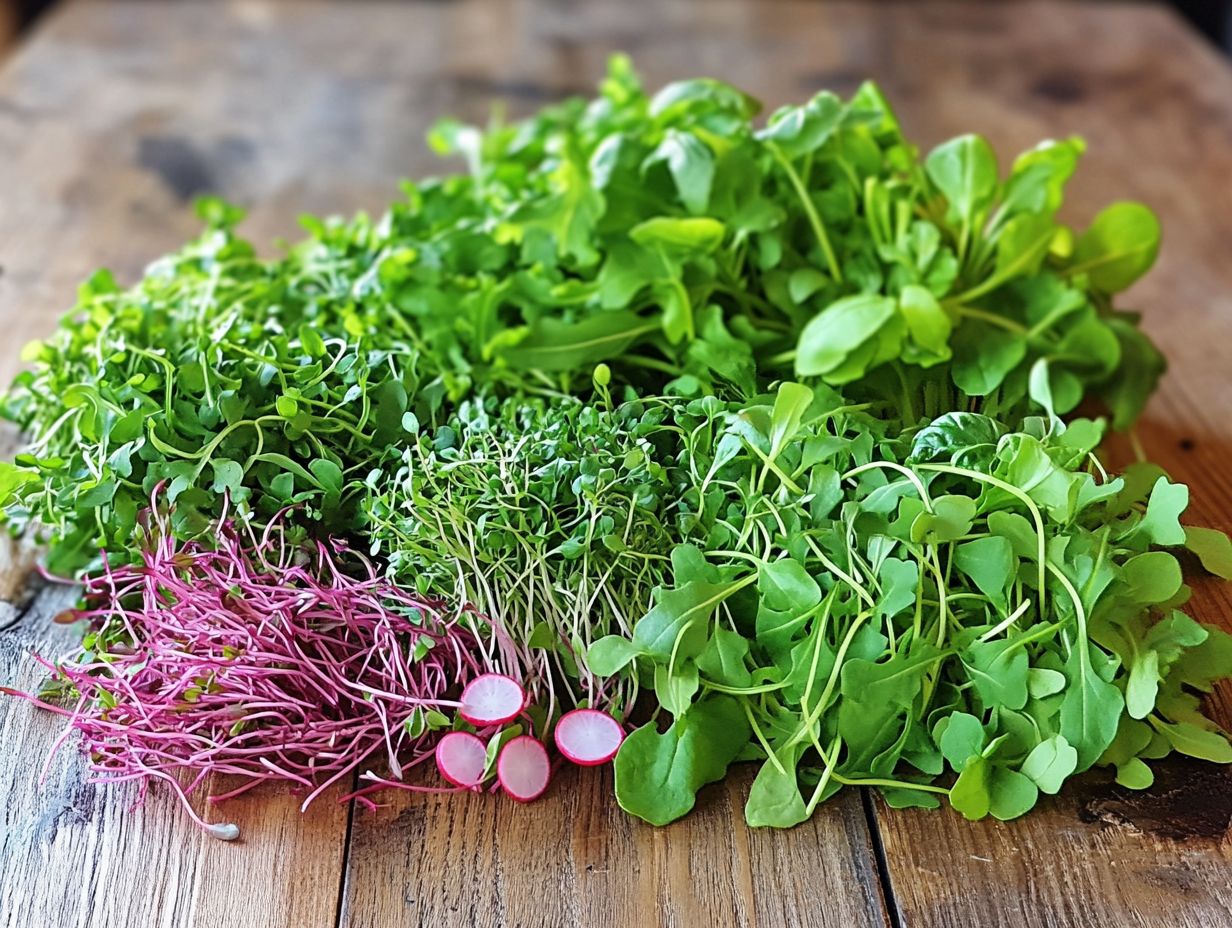
The nutritional profile of microgreens varies by plant type, but overall they are packed with vitamins, minerals, and antioxidants. They also provide fiber and small amounts of protein and healthy fats.
What are the health benefits of incorporating microgreens into my diet?
Research has shown that microgreens have a higher concentration of nutrients compared to their mature counterparts. Consuming microgreens can help boost your immune system, improve digestion, and offer a variety of other health benefits.
How can I use microgreens in my cooking?
Microgreens are incredibly versatile. Use them as a garnish for salads, soups, and sandwiches or add them to smoothies, omelets, and stir-fries for an extra boost of nutrition and flavor.
Are there any precautions I should take when consuming microgreens?
While microgreens are generally safe to eat, ensure they are properly washed. They are grown in soil and may harbor bacteria or contaminants. If you have allergies to certain plants, avoid consuming microgreens made from those plants.
Start adding microgreens to your meals today and unlock a world of flavor and health benefits!
Can I grow my own microgreens at home?
Absolutely! Microgreens are easy to grow at home. They require minimal space and equipment.
You can purchase microgreen growing kits or use a shallow container, potting soil, and seeds. With a little care, you’ll soon have a vibrant supply of fresh microgreens to spice up your meals!

